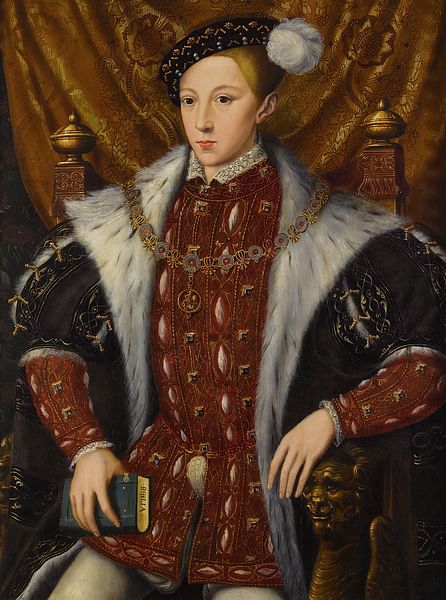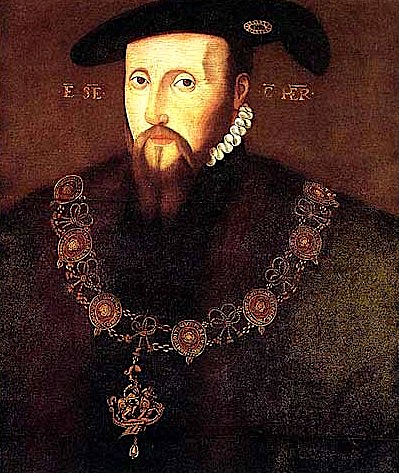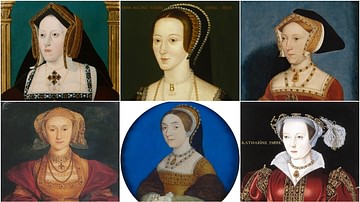
Edward VI of England reigned as king from 1547 to 1553 CE. Succeeding his father Henry VIII of England (r. 1509-1547 CE), Edward was only nine years old at the time and so the kingdom was ruled by a council of nobles, foremost among whom was Edward's maternal uncle, Edward Seymour (l. c. 1500-1552 CE) until he was replaced by John Dudley, the Earl of Northumberland (l. 1504-1553 CE). During Edward's reign, Protestant religious reforms continued as the Church of England broke further away from the traditions of the established Catholic Church directed by the Pope. There were also popular uprisings as the economy faltered and inflation was rampant. Edward's reign was short as he died of tuberculosis aged just 15. He was succeeded by his cousin Lady Jane Grey (1537-1554 CE) until what the majority of the people and nobility regarded as the rightful heir, his elder half-sister, was installed nine days later as Mary I of England (r. 1553-1558 CE).
Henry VIII & The Succession
Henry VIII married six times but it was his first three marriages that each produced a future monarch. With Catherine of Aragon (1485-1536 CE), Henry had a daughter, Mary (b. Feb. 1516 CE). With Anne Boleyn (c. 1501-1536 CE), there was another daughter, Elizabeth (b. Sep. 1533 CE). With wife number three, Jane Seymour, who was a lady-in-waiting at court, Henry had his first and last legitimate son, Edward, born on 12 October 1537 CE in Hampton Court Palace. At the joyous news, there followed 2,000 cannon shots let off in the Tower of London, bells rang out across England and there were 24 hours of parties and feasts but, tragically, Jane died 12 days after giving birth, most likely from post-natal fever.
As the first marriage was annulled to permit the second and Anne Boleyn was executed on charges of adultery, so each of their children was disinherited and it was Edward who became the official heir to the throne. As more wives came and went and no more children were forthcoming, Henry changed his mind in 1544 CE and declared that Edward could be succeeded by his half-sister Mary with Elizabeth next in line.
Henry VIII's health declined rapidly in his later years as the king became seriously overweight and suffered a badly ulcerated leg. The king died on 28 January 1547 CE at Whitehall Palace in London; he was 55 years old. Henry was buried in Saint George's Chapel at Windsor Castle, next to his late third wife, Jane Seymour, and he was duly succeeded by Edward who became Edward VI at his coronation in Westminster Abbey on 20 February 1547 CE. Henry, having split the Church in England from Rome to acquire his first marriage annulment and gone on a massive spending spree on palaces and wars, left his son an impoverished kingdom split over religious issues and, particularly, whether or not to press on with reforming the Church.

The Regency & Church Reform
As Edward was only nine when he became king, England was effectively ruled by a council of nobles, chief amongst these was the Lord Protector, Edward Seymour, the young king's uncle. Henry VIII had stipulated that the regency council not be dominated by any single individual but this proved to be a difficult principle to maintain in practice. The ambitious Seymour gave out titles and money to his supporters and promoted himself from the Earl of Hertford to the Duke of Somerset in 1547 CE, thus making himself, in effect, sole regent. Seymour was a committed Church reformer and, with the aid of such figures as Thomas Cranmer, the archbishop of Canterbury, he showed his intent from the very start of his nephew's reign by including an oath in the coronation ceremony that the king would uphold the Reformation begun by his father. Next came the 1547 CE Treason Act which lifted old restrictions and permitted the free discussion of religious matters, as well as the printing and distribution of related materials.
Seymour had his enemies amongst those Catholics not in favour of Church reform and these included his own brother Thomas Seymour, the Lord High Admiral. Edward Seymour jealously guarded his position of favour with the young king and his two half-sisters and even had Thomas Seymour executed in March 1549 CE when he tried to muscle in on the royal court.
Reforms continued apace as the term Protestantism came into widespread use for the first time. Iconography, murals, and pictorial stained glass windows were all removed from churches, and services were now conducted in English, not Latin. Catholic altars were replaced by communion tables. Priests were now permitted to marry. A new Book of Common Prayer was issued in English in 1549 CE and made compulsory under the Act of Uniformity of the same year. The prayer book was updated with an even more radical departure from Roman Catholicism in 1552 CE when the idea of transubstantiation was rejected (that the Eucharistic elements of bread and wine become the body and blood of Jesus Christ). Religious guilds were suppressed, endowments (chantries) were abolished for priests to sing mass for the souls of the dead, and church lands were confiscated. The riches gained lined the pockets of the nobility, although Edward did use some of the cash to found a number of grammar schools.

Many hard-liner traditionalists took a stand against these changes, although there was also a surprising apathy on the part of most. When religion mixed with politics, though, there were more serious consequences such as several popular uprisings. These riots and disturbances were further fuelled by land enclosures (the use of common land to create private hunting estates or grazing land for livestock), inflation (caused by heavy war costs and currency debasement), and new taxes on wool cloth and sheep. On top of these problems, the population of England had risen from 2.3 million in 1530 to 3 million in 1550 CE putting prices up as demand increased and making it difficult for some to find work. The uprisings included riots in Cornwall and the Mousehold Heath rebellion in Norfolk led by Robert Kett who audaciously declared his own commonwealth in 1549 CE. These troubles were eventually put down, some ruthlessly like the massacre at Dussindale in Norfolk (26 August) but they were enough to see Seymour removed from office and be replaced by John Dudley, the Earl of Warwick in October 1549 CE.
A Manipulated King?
Edward, meanwhile, had never displayed a particularly strong constitution as a young child, despite the careful efforts to preserve the health of what his father had called 'his most precious jewel.' The prince and then king continued his education in Latin, Greek, theology, philosophy, and the classics. Edward also practised many sports such as horse-riding, fencing, archery, and tennis, and the arts were not neglected with lessons in dancing and music, especially the lute. While the fledgeling king was thus occupied, the hawks of political office hovered around his court to take from it what they could. As the noted Tudor historian G. R. Elton noted:
Edward was naturally haughty and arrogant, like all the Tudors; also like all his family, he had a marked intellectual ability…The king was a cold-hearted prig, a fact which not even the pathos of his miserable death can make one forget. Self-righteous, inclined to cruelty, and - need we wonder at it? - easily swayed by cunning men, he exercised such little influence as he possessed in favour of disastrous policies and disastrous politicians. (202)
Foreign Policy
England's familiar enemies in war were France and Scotland, the 'Auld Alliance.' There was a plan in 1543 CE for Edward, the Prince of Wales, to marry Mary, Queen of Scots (r. 1542-1567 CE) but neither nation was keen to forgo any of their independence. The English persisted with the scheme with the so-called 'Rough Wooing' of 1544-5 CE when the Scottish lowlands were ravaged but, unsurprisingly, this policy only hardened Scottish resolve.
A campaign by Edward Seymour in Scotland in 1547 CE had met with some success, notably the victory at the Battle of Pinkie (near Musselburgh) on 10 September but no lasting advantage was achieved and the newly established English garrisons there came under repeated Scottish attack. The French were also besieging Boulogne, and Seymour's commitment of troops in France and Scotland may explain his fatal dallying when trying to deal with the popular revolts in England. Wars in two countries were, in any case, beyond the financial means of England and, accordingly, 1550 CE saw a peace treaty signed between England, France, and Scotland, the Treaty of Boulogne (so-called because Boulogne was returned to the French crown).
Dudley, Earl of Warwick
Dudley, Earl of Warwick gained the confidence of Edward and made himself the Earl of Northumberland in 1551 CE. He moved quickly to remove any rivals and even the discredited Edward Seymour was executed on 22 January 1552 CE. Edward kept a diary and his descriptions are surprisingly unemotional, even when they touch on the death of his uncle: "The Duke of Somerset had his head cut off on Tower Hill between eight and nine o'clock this morning" (Jones, 227).
Dudley pressed on with the Reformation with gusto, perhaps more motivated by greed for the church's wealth than any true religious conviction. The more radical prayer book mentioned above was introduced and further restrictions made on 'Popish' practices like the toning down of the vestments of the clergy and abolition of prayers for the dead. The economy improved somewhat thanks to anti-enclosure legislation and an end to the practice of mixing too much copper into the silver coinage which dampened inflation. The king and new regent (in all but name) worked closely together with the earl secretly teaching Edward speeches he could deliver with aplomb to the King's Council the following day. But then disaster struck. Edward contracted both measles and smallpox in the summer of 1552 CE. In 1553 CE, after a particularly harsh winter, he was showing the effects of tuberculosis and his days were numbered.

Death & Successors
The king's successor had been appointed by his father if Edward had no children: Mary, his elder half-sister, but she was an ardent Catholic and so would very likely reverse the Reformation when she became queen (and also end Dudley's career). Dudley, therefore, persuaded Edward, who was himself a keen Reformist, to nominate instead his cousin Lady Jane Grey. Edward died of pulmonary tuberculosis on 6 July 1553 CE at Greenwich Palace, aged just 15. Dudley kept the death secret for a few days while he moved to install Lady Jane Grey as queen, then just 16 years of age.
Lady Jane Grey was the great-granddaughter of Henry VII of England (r. 1485-1509 CE), granddaughter of Mary Tudor (1496-1533 CE) the sister of Henry VIII and, perhaps more significantly, the daughter-in-law of John Dudley. The king's council and Parliament accepted Edward's nomination of Jane. Unfortunately for all Dudley's carefully laid plans, Mary was not about to let this opportunity slip away, and she had plenty of support she could call upon immediately. The choice between a lady with only distant royal relations and a daughter of Henry VIII was an easy one to make for the public regardless of religious convictions. An army marched in Mary's name on London, and both the nobility and commoners were united that Henry VIII's original wish should be honoured. Mary was met by cheering crowds in London on 3 August 1553 CE. Dudley was duly ousted and Lady Jane Grey, who had been a reluctant participant in the whole nine-day scheme, was confined in the Tower of London until her execution there on 12 February 1554 CE. Dudley was executed on 22 August 1553 CE. Mary was crowned in Westminster Abbey and so became Mary I of England on 1 October 1553 CE. Mary reigned until 1558 CE when she was succeeded by her half-sister Elizabeth I (r. 1558-1603 CE), with whom arrived England's Golden Age.






